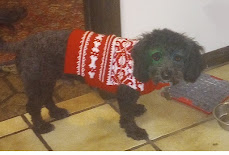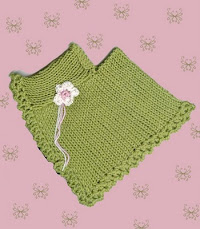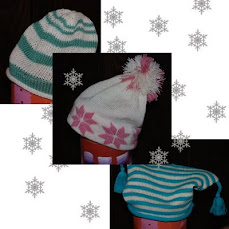Fuzzy Feet by Mar Heck ©2019
This pattern is adapted from an easy, old, hand- knit
slipper pattern that for years has been passed along from grandmother to
grandchild and probably has been knit a million times. Adding three twists to the
pattern: they are done on the machine in
lightening quick fashion in stockinette stitch, we are adding fun fur to tickle our fancy and we are
felting them to make them extra warm. MACHINE: 9 mm Bulky or midgauge
SIZES:
Child to
adult. Adult in parenthesis.
MATERIALS NEEDED:
3 (4) skeins
Lion Brand Fun Fur™ (60 yards per skein, polyester), purple used for the sample
1 (2) skeins
knitting worsted weight wool yarn (Do not use wool yarn made to resist
felting, called superwash.) Light blue used for the
sample. Large eyed needle for sewing up
SKILL LEVEL:
Beginner.
Skills
needed: Making a swatch and determining
gauge
E wrap cast
on.
Mattress stitch
for hand sewing.
DIRECTIONS:
1. Determine
the recipient’s foot size by taking two measurements. Measure the foot length from heel to toe and
then measure around the instep close to the ankle. The foot length will be the finished slipper
length (number of rows) and the width
will be how high the slipper comes up each side of the foot on the sides of the
heel/ankle (number of stitches). The
slipper is just a plain rectangle.
2. Make a
swatch . You will make the slipper
the size of the felted gauge. With one strand of fun fur and one strand
of the wool held together, e wrap cast on 20 stitches and knit 30 rows at the
largest tension your machine will do.
End with waste yarn and remove from machine. The waste yarn will tell you which direction
is the rows. If it felts really well,
it’s hard to otherwise tell which direction is which. It will feel like a big waste of yarn, but
you’ll only have to do this once for a particular brand of wool. (You might be able to later think of a use
for this little swatch.) Throw the
swatch in the washing machine until the wool felts. Depending on the yarn you choose it may take
a few cycles for it to felt. After it
attains the look you want, measure the swatch to determine stitches and rows
per inch or centimeters, whichever you are more comfortable with. Multiply the stitches and rows per inch
times the dimensions you want to determine how many stitches and rows you will
knit for your rectangle. (See note below
for calculating.) Note that it will have shrunk more in length than in width.
***If you prefer not to make a swatch, for a rough reference: using the largest tension, my
child’s slipper turned out to be at T 10.. 44 stitches X 50 rows to fit an 7-8”
foot. My adult women’s slipper, about a
size 9, turned out to be 50 stitches X 74 rows to fit a 9 -10 inch foot.
Because felting is not an exact science, you’ll need to do a little
experimenting with the yarn you choose. If
you use the same yarns for different sizes, you can knit a pair using your best
guesses for stitches and rows then adjust for other sizes by adding or
subtracting stitches and rows. This works fine if you would prefer not to waste
yarn on a swatch. (You can’t reuse yarn
that’s been felted, so some people would prefer to just dive right in.) Another thought: you will want the slipper
to be a bit snug, so do not add any ease.
3. Directions
for knitting. Knit one rectangle for
each slipper.
* E wrap cast
on loosely from left to right with one strand of each yarn held together over
the number of needles you have
determined you need. Leave a yarn tail
at the beginning about 10” long to later sew up the heel seam.
* Put the yarns
together in the feeder and turn the dial to the largest tension number. Set your row counter to zero and knit one row
from right to left. (May be a bit hard
to push the carriage.)
* Hook the cast
on comb into the stitches. Add as much
weight across the knitting as you can. Use ribber weights if you have
them. For the first 2-3 rows, pull all
needles out to E position each row to make the stitches knit off a little
easier. Yank the knitting down after
each row so that the fur doesn’t get hung up on the gate pegs. Knit the number of rows you have determined
you need.
* End with the
carriage on the right side. Take the
yarn out of the feeder and cut a length of the two yarns about 1 ½ feet long
which will be used for sewing up the top of the slipper. ( I sewed mine first then felted them. ) Thread both strands into a large eyed needle and take the stitches off their
needles, one at a time from right to left onto this thread. When all stitches are off the machine, pull
the stitches as tight as you can. This
will be the toe. You will most likely
have a little hole, so stitch across the hole from north to south and east to
west a few times. Neatness doesn’t count
because the felting and the fur will hide your sewing.
* Don’t break yarn.
With this same length of yarn, sew up the top of the foot seam with a
mattress stitch from the toe towards the back of the slipper. Again, for reference, I sewed a 3 inch seam
for the child’s slipper and a 4 inch seam for the adult. Fasten off by sewing through your last stitch
again and then hide the yarn tail inside the slipper by sewing through the
backs of 5-6 stitches and cutting the yarn off. You need a large enough opening to slip the
foot into, but small enough to stay on snugly.
* Thread both
strands of your beginning yarn tail into a large eyed needle and sew up the
heel seam. You will be folding the back of the slipper in half and sewing from
top to bottom. The stitches face each
other, so you can’t do a mattress stitch.
Any seam will do. Sew twice for strength. Hide the yarn tail as above.
* Note: the edge that ends up around the ankle needs
no treatment. When felted it lies
perfectly flat. No problem there!
4. Felt both
slippers at the same time in the same wash load(s) giving them the same
treatment as you did your swatch. My
wool needed 3 hot/cold cycles to felt, but each yarn brand seems to behave
differently as do different colors, so you just need to monitor it. When felted to the size you need, scrunch up
some plastic bags, stuff the slippers so they have a nice shape and let them
dry for a day or so. Petting them doesn’t
prolong the drying period, so have at it.
It’s amazing how the wool pulls together and makes the non-felting
polyester “fur” more dense. People are
kind of surprised you can do this on a machine.
Just one bit of warning, they’re slippery on smooth floors.
5. I found this
addictive and made several pairs. They are so soft and cozy! For your next
pair, you can do stripes and/or embellish them with bows, eyes, ears, tails,
whatever. Baby booties would be really
cute and easy. Because of the slippery
nature of the slippers (is that how the
word came about?), the pattern may not be appropriate for toddlers or older
folk. You decide. Once you have your gauge, the next pair is a
snap. They are so silly, they’re fun!
New Knitter Notes:
Ewrap Cast On:
Pull needles that are going to be in work out to E
position. Make a slip knot and hang it
on first needle on the left. Push the
knot back to the needle bed. Just as
though you were writing a cursive “e”, wrap the yarn around each needle counter
clockwise, from left to right up against the bed, not in the hooks of the
needles. Easy does it---don’t wrap too
tightly. No need to wrap the last needle
on the right. Just put the yarn in the
yarn feeder and that stitch will knit automatically as you push the carriage
from right to left. After your first
row, hang the cast-on comb.
One way to calculate the stitches and rows per inch:
This simple method works in this case since we are
dealing in approximations anyway. For a
sweater, you would want to do a more extensive swatch. In this example, you knit 20 stitches and 30
rows and then felt your swatch. When it
has felted to your liking, measure the width.
Say your swatch, after felting, measures 4 inches across. 20 stitches divided by 4 inches = 5 stitches
per inch. To get your number of stitches
for the width of the slipper, multiply 5 times the number of inches you
want. Say the length ended up to be 5
inches. 30 rows divided by 5 inches = 6
rows per inch. To get the number of rows
for the length of the slipper, multiply 6 times the number of inches you want.
Hand sewing a mattress stitch:
Have the right sides of both pieces facing you, side
by side. With your large needle, go
under two bars on the right side of the first stitch of the piece on the right,
then under two bars on the left side of the first stitch on the left
piece. Go back and forth repeating from
side to side, pulling the yarn taut now and then. The stitches from each side pull together
making the seam invisible from the right side.














































































